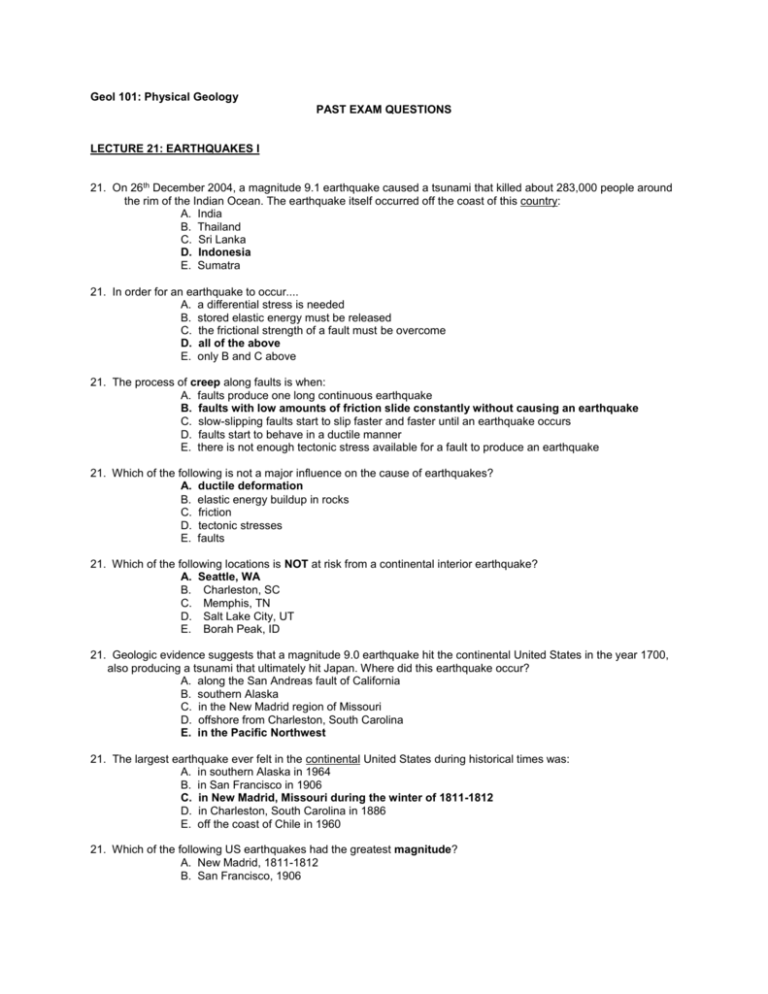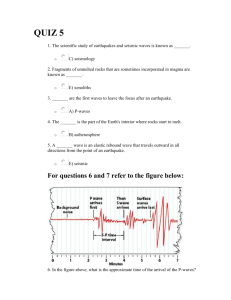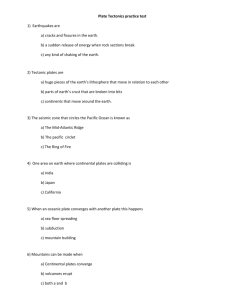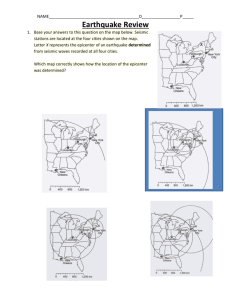E. P-wave
advertisement

Geol 101: Physical Geology PAST EXAM QUESTIONS LECTURE 21: EARTHQUAKES I 21. On 26th December 2004, a magnitude 9.1 earthquake caused a tsunami that killed about 283,000 people around the rim of the Indian Ocean. The earthquake itself occurred off the coast of this country: A. India B. Thailand C. Sri Lanka D. Indonesia E. Sumatra 21. In order for an earthquake to occur.... A. a differential stress is needed B. stored elastic energy must be released C. the frictional strength of a fault must be overcome D. all of the above E. only B and C above 21. The process of creep along faults is when: A. faults produce one long continuous earthquake B. faults with low amounts of friction slide constantly without causing an earthquake C. slow-slipping faults start to slip faster and faster until an earthquake occurs D. faults start to behave in a ductile manner E. there is not enough tectonic stress available for a fault to produce an earthquake 21. Which of the following is not a major influence on the cause of earthquakes? A. ductile deformation B. elastic energy buildup in rocks C. friction D. tectonic stresses E. faults 21. Which of the following locations is NOT at risk from a continental interior earthquake? A. Seattle, WA B. Charleston, SC C. Memphis, TN D. Salt Lake City, UT E. Borah Peak, ID 21. Geologic evidence suggests that a magnitude 9.0 earthquake hit the continental United States in the year 1700, also producing a tsunami that ultimately hit Japan. Where did this earthquake occur? A. along the San Andreas fault of California B. southern Alaska C. in the New Madrid region of Missouri D. offshore from Charleston, South Carolina E. in the Pacific Northwest 21. The largest earthquake ever felt in the continental United States during historical times was: A. in southern Alaska in 1964 B. in San Francisco in 1906 C. in New Madrid, Missouri during the winter of 1811-1812 D. in Charleston, South Carolina in 1886 E. off the coast of Chile in 1960 21. Which of the following US earthquakes had the greatest magnitude? A. New Madrid, 1811-1812 B. San Francisco, 1906 C. Southern Alaska, 1964 D. Fort Tejon, 1857 E. Pacific Northwest, 1700 21. The Great San Francisco earthquake in 1906 was the most devastating earthquake in the history of the United States, killing about 3,000 people. This magnitude 7.8 earthquake happened because of motion along the: A. Cascadia subduction zone B. Aleutians subduction zone C. San Andreas fault D. Borah Peak fault E. Basin and Range faults 21. The largest earthquake in the United States during historic times, as well as being the second largest earthquake ever recorded, was: A. in southern Alaska in 1964 B. in San Francisco in 1906 C. in Idaho in 1983 D. in Charleston, South Carolina in 1886 E. in Hawaii in 2006 21. The largest earthquake in historic times had a magnitude of 9.5 and occurred off the coast of: A. Peru B. Chile C. Mexico D. Alaska E. Indonesia 21. The record of an earthquake’s seismic waves is a series of zig-zag lines traced from left to right, called a: A. seismogram B. seismograph C. seismometer D. seismologist E. magnitudometer 21. Seismic waves are recorded by an instrument called a (1) _________ and the record of the earthquake that the instrument generates is called a (2) _________. A. (1) seismograph (2) seismometer B. (1) seismograph (2) seismogram C. (1) seismometer (2) seismograph D. (1) seismogram (2) seismograph E. (1) seismogram (2) seismometer 21. The focus of an earthquake is: A. the location of a fault scarp at the earth’s surface where the earthquake rupture starts B. the point inside the earth from which body waves radiate into the surrounding rocks C. the point on the earth's surface where surface waves radiate out into the surrounding rocks D. exactly the same as the epicenter of an earthquake E. always at the earth's surface 21. The epicenter of an earthquake is: A. the location along a fault where the earthquake rupture starts B. the point from which body waves radiate into the surrounding rocks C. the point on the Earth's surface directly above the earthquake focus D. exactly the same as the focus of an earthquake E. sometimes at the Earth's surface, but not always 21. The first seismic wave to arrive from an earthquake is: A. the S-wave B. the P-wave C. the Love wave D. the Rayleigh wave E. variable from earthquake to earthquake 21. The type of seismic wave that has the same characteristics as sound waves is the: A. body wave B. surface wave C. S-wave D. Love wave E. P-wave 21. Which seismic wave is a type of body wave that moves through rocks with a back and forth motion, like a snake? A. P-waves B. Love waves C. Rayleigh waves D. sound waves E. S-waves 21. The first two seismic waves to arrive after an earthquake are: A. the S-wave then the P-wave B. the P-wave then the S-wave C. the Love wave then the Rayleigh wave D. the Rayleigh wave then the Love wave E. dependent on the distance to the earthquake 21. Which of the following types of waves is unable to pass through any liquid? A. P-waves B. sound waves C. water waves D. primary waves E. S-waves 21. If you are in a swimming pool during an earthquake, the only body wave you will feel is the: A. P-wave B. S-wave C. Love wave D. Rayleigh wave E. you won’t feel the earthquake at all 21. The order of arrival of seismic waves is: A. body waves, primary waves, surface waves, secondary waves B. P-waves, primary waves, S-waves, secondary waves C. P-waves, S-waves, Love waves, Rayleigh waves D. Love waves, primary waves, surface waves, Rayleigh waves E. Rayleigh waves, secondary waves, primary waves, Love waves 21. The slowest of all the types of seismic waves are the: A. Love waves B. S-waves C. Rayleigh waves D. P-waves E. body waves







